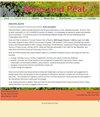从菌种选择到培养基生产的泥鳅养殖研究进展
IF 1.5
4区 环境科学与生态学
Q4 ENVIRONMENTAL SCIENCES
引用次数: 48
摘要
泥炭种植——在重新湿润的沼泽上生产泥炭生物质——通过阻止排水泥炭的温室气体排放和用可再生的生物质替代泥炭,有助于实现全球气候目标。大规模实施Sphagnum种植需要广泛的专业知识,从最初的物种选择到最终生产和使用Sphagnum生物质园艺生长介质。本文概述了过去15年来积累的相关知识,并确定了尚未解决的问题。本文章由计算机程序翻译,如有差异,请以英文原文为准。
Sphagnum farming from species selection to the production of growing media: A review
Sphagnum farming - the production of Sphagnum biomass on rewetted bogs - helps towards achieving global climate goals by halting greenhouse gas emissions from drained peat and by replacing peat with a renewable biomass alternative. Large-scale implementation of Sphagnum farming requires a wide range of know-how, from initial species selection up to the final production and use of Sphagnum biomass based growing media in horticulture. This article provides an overview of relevant knowledge accumulated over the last 15 years and identifies open questions.
求助全文
通过发布文献求助,成功后即可免费获取论文全文。
去求助
来源期刊

Mires and Peat
ENVIRONMENTAL SCIENCES-
CiteScore
2.30
自引率
16.70%
发文量
0
审稿时长
33 weeks
期刊介绍:
Mires and Peat is a peer-reviewed internet journal focusing specifically on mires, peatlands and peat. As a truly “free-to-users” publication (i.e. NO CHARGES to authors OR readers), it is immediately accessible to readers and potential authors worldwide. It is published jointly by the International Peatland Society (IPS) and the International Mire Conservation Group (IMCG).
Mires and Peat is indexed by Thomson Reuters Web of Science (2017 Impact Factors: 1.326 [two-year] and 1.638 [five-year]), Elsevier Scopus, EBSCO Environment Complete, CABI Abstracts, CSA Proquest (including their Aquatic Science and Fisheries Abstracts ASFA, Ecology, Entomology, Animal Behavior, Aqualine and Pollution databases) and Directory of Open Access Journals (DOAJ). Mires and Peat also participates in the CABI Full Text Repository, and subscribes to the Portico E-journal Preservation Service (LTPA).
Mires and Peat publishes high-quality research papers on all aspects of peatland science, technology and wise use, including:
ecology, hydrology, survey, inventory, classification, functions and values of mires and peatlands;
scientific, economic and human aspects of the management of peatlands for agriculture, forestry, nature conservation, environmental protection, peat extraction, industrial development and other purposes;
biological, physical and chemical characteristics of peat; and
climate change and peatlands.
Short communications and review articles on these and related topics will also be considered; and suggestions for special issues of the Journal based on the proceedings of conferences, seminars, symposia and workshops will be welcomed. The submission of material by authors and from countries whose work would otherwise be inaccessible to the international community is particularly encouraged.
 求助内容:
求助内容: 应助结果提醒方式:
应助结果提醒方式:


